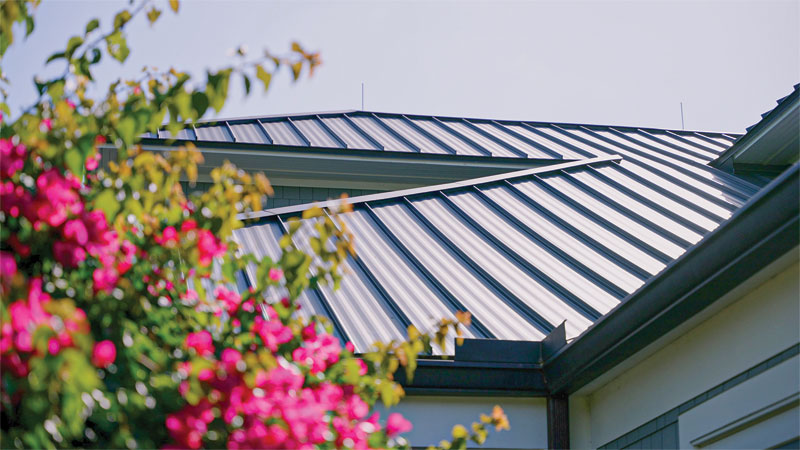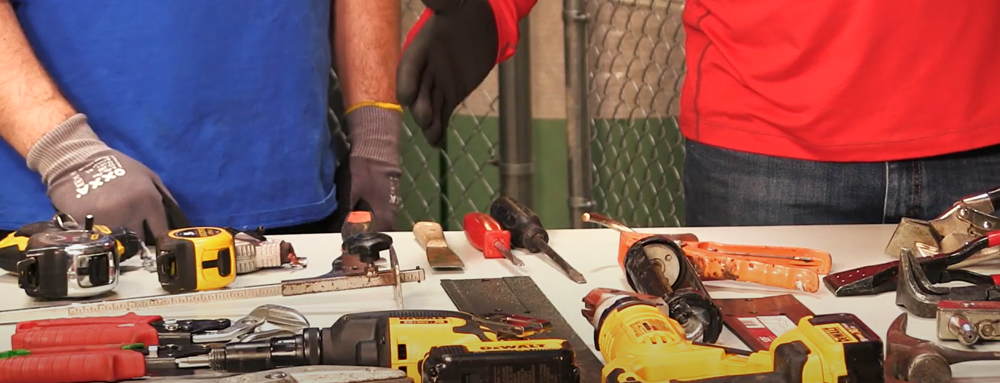Prime Roofing: Metal Roofing Products & Accessories
Introduction
Metal roofing systems rely on many specialized components beyond the metal panels themselves. Each accessory plays a critical role in waterproofing, wind resistance, and energy efficiency. For example, properly interlocked standing-seam metal panels – as shown below – can last 40–70 years. In hurricane-prone areas like Florida, metal roofs properly engineered can withstand winds in excess of 140 mph. All accessory products (fasteners, underlayment, sealants, etc.) work together to achieve that performance.

Fasteners
Metal panels alone shed most rain, but penetrations, laps, and edges must be sealed with the right hardware. Contractors use color-matched, corrosion-resistant screws and fasteners to anchor panels and trim. These fasteners (screws, rivets, clips) ensure structural integrity and weather resistance. For example, self-drilling metal screws with built-in washers attach panels to steel framing, while specially threaded wood screws hold panels to a plywood deck. Aluminum or stainless fasteners are chosen for corrosion resistance, and “TruGrip” or similar high-strength fasteners are used in high-stress zones. All exposed screws have EPDM (rubber) sealing washers to prevent leaks: the washer acts as a mini water-tight gasket under the screw head. For a finished look, fasteners often come in roof‐panel colors (black, white, gray, etc.) so they blend seamlessly with the roof. Properly spaced and sized fasteners (often 16″–24″ on center in high-wind areas) and robust clips prevent panel uplift during hurricanes.
- Self-drilling metal screws: Attach panels to metal framing without pre-drilling; made of galvanized or stainless steel for durability.
- Wood screws: Coarse-thread screws for fastening panels to plywood or wood purlins; aggressive threads grip wood and resist loosening.
- Pop rivets (42/44): Used in places where screws aren’t practical (e.g. panel overlaps or gutter seams); they provide a vibration-resistant, low-profile connection.
- High-performance fasteners: Specialty clips like “TruGrip” offer extra sealing and grip in extreme weather.
- Washers and gaskets: EPDM or neoprene rubber washers under each screw keep water out of the hole. (EPDM is chosen for its durability in heat, UV, and ozone.)
Underlayment
A hidden underlayment layer beneath the metal panels is vital for leak protection and longevity. High-quality synthetic underlayment provides a secondary water barrier: it self-seals around nails, screws, and fastener clips so that any moisture or condensation cannot penetrate to the roof deck. This is especially important during freeze-thaw cycles or wind-driven rain. The underlayment also acts as a vapor barrier, preventing moisture buildup under the panels that could otherwise cause rot or corrosion. In hot climates, a high-temp rated underlayment guards against adhesive failure in extreme heat (e.g. up to 250 °F). It even provides a smoother, uniform surface that improves panel fit and finish.
- Moisture Barrier: The underlayment blocks water intrusion at seams and fastener penetrations (self-sealing around screws).
- Vapor Barrier: It limits condensation by controlling vapor diffusion into roof cavities.
- Heat & Energy: A good underlayment can reduce heat transfer, improving attic insulation performance. When combined with reflective panels or coatings, it helps keep indoor temperatures stable.
- Noise Dampening: Some underlayments also dampen rain noise, addressing a common homeowner concern about metal roofs.
- Durability: Underlayment extends roof life; any breach in the metal panels (scratches, seams) is backed up by this robust layer.
Radiant Barriers
For maximum energy efficiency—especially in hot climates like Florida—a reflective radiant barrier or reflective insulation is added under the roof deck. Metal roofs already reflect much of the sun’s UV and infrared heat, but a radiant barrier (typically a foil-faced insulation or sheathing) can further block up to 97% of radiant heat from entering the attic. In practice this can drop attic temperatures by ~30 °F and cut cooling loads significantly. Roofing manufacturers offer “cool roof” panel coatings in tandem with radiant barriers to maximize reflectivity. In short, a proper radiant barrier under a metal roof ensures that solar heat is bounced back outdoors, reducing air-conditioning costs.
- Reflective foil-faced sheathings or bubble insulation block radiant heat, making the roof assembly highly energy-efficient.
- When paired with a reflective metal finish, the combined effect “reduces the heat transfer” into the home.
- Energy-conscious homeowners in hot regions often install these barriers to achieve higher LEED ratings or lower HERS scores.
Sealants and Cauks
Flexible sealants are used wherever metal panels or trim pieces join or meet another surface. Silicone, polyurethane, and advanced polymer (“MS Polymer”) sealants are all common in metal roofing. Each serves to fill gaps and bond joints that water might exploit, such as around vents, ridge caps, trim edges, or overlap seams.
- Silicone Sealant: Extremely UV- and moisture-resistant. Good for high-temperature or continuous exposure areas (such as ridge vents or skylights), since it stays flexible in heat. It cannot be painted and can tear if over-stressed.
- Polyurethane (Urethane) Sealant: Economical and adhesive, but less ideal in very hot or continuously wet applications. (It tends to be stiffer at low temps.)
- Hybrid Polymer Sealant (e.g. MS Polymer): Combines durability of silicone with paintability of urethane. These modern sealants have shown superior performance in hurricane conditions and are often available in roof colors.
- Joint Sealant / Mastic: Thick butyl or poly-foam mastics are used for pitch pans or wide gaps. They remain permanently elastic and will not harden or crack.
During installation, sealant is applied with a caulking gun (often a high-ratio gun for efficiency). Typical sealant applications include bedding ridge caps, flashing transitions, and covering the tops of fastener heads (if not using pre-coated screws). In essence, high-quality roof sealants stop leaks by filling capillary gaps and gluing panels together at trim points.
Roof Boots and Flashings
Every penetration (vent pipe, stack, chimney cap, etc.) requires a weather-tight flashing boot. A roof boot is a molded collar (rubber, EPDM, or silicone) that seals around the pipe and anchors to the metal panel. Without a proper boot, even a strong metal roof can leak around pipes.
- EPDM Pipe Flashing Boots: Common for plumbing vents. These have a flexible rubber cone that compresses around the pipe and a rigid aluminum base. EPDM is rated for continuous exposure (to ~212 °F) and resists UV and ozone. For example, EPDM “Roofjack” boots are widely used for metal roofs. They come in square or round bases and in retrofit (split) models for installed pipes.
- High-Temp Silicone Boots: For chimneys or high-heat vents (wood stoves, stoves, furnaces), silicone boots handle extreme temperatures (400 °F+) without shrinking.
- Flexible Aluminum Base: Quality boots (e.g. Dektite brand) use a bendable aluminum flange that conforms to the roof panel ribs. This ensures the boot lies flat on the corrugated or ribbed panel. The collar material (rubber or silicone) then overlaps the pipe itself, providing a tight seal.
- Durability: These boots are designed to last decades in sun and storms. EPDM boots are ozone/UV resistant, and aluminum collars won’t rust.
In summary, a metal roof’s resilience to rain and wind depends on flawless flashing around every penetration. Properly installed, these boots keep water out of the roof deck and prevent rust or rot under the roof.
Snap-Z Ridge Vents and Closures
Ventilation is important for a roof’s overall performance. Snap-Z is a brand of standing-seam ridge vents and closures commonly used on residential metal roofs. A Snap-Z ridge vent snaps into place at the roof peak and contains a foam closure and pre-applied sealant tape. For instance, the Snap-Z 1000™ vent fits a 1″ standing-seam and comes pre-punched for screws with pre-applied butyl tape, so installation is quick. The foam closure beneath the vent prevents insects and rain from entering.
These ridge vents are engineered for storm performance: the Snap-Z 1000 model is rated for 110 mph wind-driven rain. It carries a Florida product approval (FL39250) demonstrating compliance with high-wind codes. By providing continuous airflow along the ridge, Snap-Z vents allow heat and moisture to escape the attic while keeping the roof watertight. In short, Snap-Z connectors (vents and closure strips) are high-performance venting accessories that clip under the ridge cap, maintaining both ventilation and weather resistance.
Butyl and Sealant Tapes
Butyl tape is a rubber-based adhesive tape used as a “gasket” in many metal roof joints. It is applied under overlapping panels, flanges, and flashings to stop capillary leaks. Unlike liquid caulk, butyl tape stays permanently elastic and won’t dry out or lose adhesion with building movement. For example, butyl sealant tape is commonly used at end laps, side laps, and around vent pipe bases.
- Panel Lap Sealing: A strip of butyl tape between overlapping panel edges creates a water-tight seal.
- Trim and Flashings: Butyl (often called “tacky tape”) seals under ridge caps, Z-flashing, and around chimneys/skylights. It adheres to metal even in very cold or hot temperatures.
- Durability: Good butyl tape is 100% solids (no solvents) and remains sticky from –40 °F to +180 °F. It will not become brittle or crack.
In sum, adhesive sealant tapes are essential for weatherproofing the small gaps that hardware or trim can’t cover. They bridge any tiny openings and ensure a unified, weather-tight envelope.
Cutting and Forming Tools
Metal roofing panels must often be cut and trimmed on-site to fit roof edges, penetrations, and architectural features. Special tools make this work safe and precise:

- Aviation Snips (Tin Snips): Manual snips (green, red, yellow handles) cut straight, left, or right curves in panels. Every roofer carries these for small cuts, notching corners, or trimming drip edges.
- Electric Metal Shears: Cordless or drill-mounted shears (such as Malco TurboShear) make long straight cuts across corrugated or flat panels. They reduce burrs and distortion compared to a saw.
- Nibblers: Drill-attached nibbler bits punch out curves and holes without bending the panel. They are ideal for circular cuts around vent pipes or irregular shapes.
- Circular Saw / Saw with Metal Blade: A 7¼″ saw fitted with a fine-tooth carbide blade can quickly cut metal roofing panels in straight lines. (Always follow safety and remove debris when cutting.)
- Metal Brake / Hand Seamer: To form edges or close seams, a hand seamer tool or rubber mallet is used to bend metal neatly. For example, ending panels at hips or forming drip-edge requires careful bending.
- Utility Knife: For trimming underlayment or making starter strip cuts.
Conclusion
By using the right accessories, homeowners can ensure their metal roofs provide long-lasting protection and energy efficiency.
